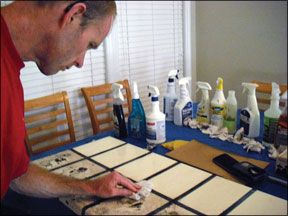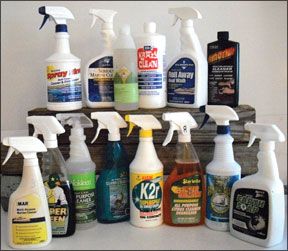One popular marine catalog dedicates 14 pages in its maintenance section to marine cleaners, polishes, and waxes. Within those pages exist dozens of specialty cleaners-cleaners for the bilge, nonskid, vinyl, carpet, black streaks, mildew, waterline stains. Theres even one to remove spider stains-really. Browsing the pages left us wondering, “Whatever happened to the old-fashioned all-purpose cleaner, the stuff that can tackle the majority of cleaning jobs on a boat, everything from dirt to grease to mildew?”

What if youd rather go with one do-it-all cleaner and use some extra elbow grease if necessary instead of buying every pricey specialty cleaner on the market? As it turns out, some well-known manufacturers of specialty marine cleaners-including Star brite, Marykate, and Yacht Brite-also make products for general cleaning, so we launched a test to find the best multi-purpose cleaners on the market.
What We Tested
We tested a total of 15 products, a cross-section of cleaners from popular marine manufacturers; however, testers dropped one product from the review, Green Ocean Products Go1 Multi Task Cleaner (www.greenoceanproducts.com), because the company is coming out with an updated version of it in the near future. Well test it when it becomes available.
Five of the 14 test products reported on are labeled as environmentally friendly, or green. They are Shaklee Basic H2 Organic Super Cleaning Concentrate, Star brite SeaSafe All-Purpose Citrus Cleaner and Degreaser, Spray Nine Bio-based Earth Soap, and Biokleen All-Purpose Cleaner. None of the test products carry the U.S. Environmental Protection Agencys Design for the Environment (DfE) logo, which PS uses as a benchmark for evaluating green products. Cleaners that carry the logo have undergone extensive screening by the EPA and other labs to ensure that none of their ingredients are harmful for humans or the environment.
Three of the test cleaners were concentrated formulas: Basic H2, Spray Nine Bio-based Earth Soap, and Driven Multisurface Cleaner Concentrate. Yacht Brite also is sold as a concentrate in the 1-gallon size, but we tested the 32-ounce regular formula. Two products, MDRs Krazy Clean and Marykates Heavy Duty Roll Away Boat Wash, are not identified as concentrated cleaners but require the user to wet the surface to be cleaned with water before application. Testers also included a “homebrew” cleaner for comparison: a water and white vinegar solution mixed with a 16:1 ratio.
Most of the test cleaners are sold in spray bottles ranging from 16 to 32 ounces. A couple of the concentrated ones, including the Basic H2 and Driven concentrates, are packaged in capped bottles without spray nozzles; this makes sense as users have to mix them with water in a separate bottle anyway.
Prices range from $2.19 for a 32-ounce bottle of non-concentrated Biokleen to $19.95 for a 16-ounce bottle of the Driven concentrate. But the majority are priced from $6 to $12 per container; the prices were found on the Web and are subject to change.
Weve broken down pricing to cost-per-ounce in the Value Guide on page 14. Biokleen led the way at 12 cents per ounce, followed by Nautical Ease at 25 cents, and Spray Nine at 26 cents. Because they are meant to be diluted, the concentrated cleaners will likely last longer, making them the least expensive when fully diluted. But were getting ahead of ourselves. The prices really come into play after the test results are in.
Testers put each cleaner through a series of bench tests simulating real-world use. Following manufacturers instructions, testers used them to clean fiberglass, Formica, rubber, and vinyl. Read more about the tests in “How We Tested” on page 15.
To get an idea of how the multi-purpose cleaners stack up against the best specialty cleaners, we compared them to the top picks from our most recent degreasers (February 2010) and mildew removers (January 2009) tests. A few of the multi-purpose products, including Spray Nine Earth Soap and Star brite Super Orange, were tested for both the general cleaners and degreasers articles because they claimed to be both. Top picks in the degreaser test were Krud Kutter Degreaser/Stain Remover and Marykates Grease Away Engine Degreaser. The Budget Buy in the evaluation, Holy Cow Heavy Duty Degreaser, is no longer available, and Raymarines Marine Shield Heavy Duty Cleaner, which we had planned to test, also has been discontinued.

PSs favorites in the 2009 liquid mildew remover test were top performer Klean-Strip, which contains bleach, and the bleach-free Nautical Ease and Spray Nine. Testers recommended Thetfords Mildew Stain Remover as the green-cleaner pick in that test.
What We Found
In the fiberglass test, all of the cleaners removed the dirt, the engine grease, and the oil, and the tester gave them all an Excellent rating. The grease and grime just didnt seem to sink into the fairly new, healthy fiberglass, so they easily wiped away. The vinegar and water solution, however, had a hard time removing the grease and scored only a Fair.
The yellow rubber hose posed a much tougher challenge for the test cleaners. The standout performers in the rubber test were K2r Superspray All Surface Cleaner, Star brites Super Orange and its Sea Safe Citrus Cleaner, Marine Spray Nine, MDR Krazy Clean, and Driven. Earning Excellent ratings, all six removed almost all the black grime and restored the hose to its original color.
Good ratings went to Imar Multi-Purpose Marine Cleaner and Star brite Super Green. The two removed more than half of the black staining. The remainder of the field struggled, earning Fair and Poor ratings as they left most of the black stain on the hose. The vinegar-and-water solution also scored a Poor.
The vinyl seat cushions presented a challenge, too. Three products received Excellent ratings: Star brite Super Green, Marine Spray Nine, and MDR Krazy Clean. Testers reported that these products required little elbow grease to remove the grease. The trio left their respective sections the cleanest. Nine other products came away with Good ratings, while three test cleaners and the vinegar-water solution were given Fairs. According to Shurhold, maker of Yacht Brite, allowing their cleaner to sit for several minutes on tough stains will pay off in less scrubbing required as it allows the cleaner to do the work rather than the person scrubbing.
In the tests on Formica, seven cleaners left their sections bright white to earn Excellent ratings. Stains remained in the sections cleaned by the K2r, Yacht Brite, Spray Nine Earth Soap, and the vinegar-and-water solution.
pH Testing
When choosing a multi-purpose cleaning product, its a good idea to look for one where the pH level is balanced so that it is an effective cleaner but isn’t so strong that it will harm the surface being cleaned. This is especially important if the surface has a sealant or wax coating.
The pH scale runs from zero to 14. The mid point of the range, 7, is considered neutral; pure water is a neutral liquid. Liquids that have a pH higher than 7 are considered to be basic, or alkaline; most hand soaps and bleach are alkaline cleaners. Basic or alkaline cleaners do well at removing oils and fats, so if youre looking to degrease your engine, try a cleaner with a high pH.
Solutions with pH levels measuring zero to 6 are considered acidic; coffee, sodas, and lemon juice are examples. Acids break down difficult stains, making them easier to remove. So if youre looking to get some rust off your deck or scrub away a waterline stain, a cleaner with a low pH will do a better job than one with a high pH. Anytime you use an acidic cleaner, however, be sure to rinse the area being cleaned with fresh water afterward.
Testers used a universal indicator testing kit to determine each test products pH level. The same kit was used to detect chlorine in the cleaners. None of the test products showed signs of chlorine, but most of the pH levels fell in the mid range (between 6 and 8).
The kit employs paper test strips impregnated with substances that change color around specific pH values. According to our indicator, if the test strip turns blue, the test liquid is strongly alkaline and has a pH of about 11; an example of an alkaline liquid would be ammonia, which has a pH of 11.9. If the paper turns green, the test liquid is weakly alkaline and has a pH around 8 (baking soda or sea water are examples); yellow indicates a weakly acid liquid with a pH of about 6 (citrus juices); a change to orange shows a strongly acid liquid with a pH of 4 or less (sulfuric acid); and a change to red means the liquid is very strongly acid with a pH of 2 or less (battery acid).
The majority of the cleaners we tested turned their strips either yellow (pH of 6) or yellow-green (a pH of 6-8), making them weakly acidic. Marine Spray Nine came closest to turning the test strip blue, measuring a pH of 9 and making it an alkaline cleaner.
The vinegar-and-water solution showed a strongly acidic pH of 4, which was expected as it contains acetic acid. In every test, the vinegar solution lagged behind the manufactured cleaners, having particular trouble removing the grease stains. The fact that most of the test cleaners exhibited pH levels of 8 or lower, however, does help explain the results of our wax test. See below.
Wax On, Wax Off
Tiny beads of water covered the fiberglass panel after we waxed it with West Marine Pure Oceans with PTEF. It was a thing of beauty, but that did not last.
The panel turned ugly after we applied the cleaners, and nary a water bead could be found. Instead, streaks of water filled the test panel, unequivocally proving that none of the test cleaners should be used on a waxed hull unless the user plans to re-wax the fiberglass.
Conclusions
Two cleaners tested best: MDR Krazy Clean and Marine Spray Nine, Practical Sailors Best Choice picks for general-purpose cleaners. For a green cleaner, we recommend Spray Nine Bio-based Earth Soap for vinyl and rubber, and to tackle Formica, we suggest Biokleen.
Marine Spray Nine showed the highest pH level and should not be used on glass or LCDs, but the product is chlorine free and has proven itself over the years in our tests. It can be found online for a good price. Regular Spray Nine is basically the same product as its marine-market sibling, but it is less expensive and can be found at stores like Ace Hardware and True Value. We found it online for $4.18 (for a 25-ounce bottle), which equates to 17 cents per ounce, earning it the Budget Buy title.
Nautical Ease Spray Boat Cleaner also scored high in tests and carries a low price: 25 cents an ounce. Other products that scored well across the board were all three Star brite products and Driven Multisurface Cleaner Concentrate.


































